In neuroscience plasticity signifies the brains capacity for livelong adaptation and ongoing structural change. The brain is thus an organ that finds itself in a process of permanent becoming.Any structural change in the brain is related to learning or un-learning skills or habits. Unlearning a habit or skill is more difficult than learning a new skill. As any learning process modifies the structure of your brain to some degree it also modifies the way you perceive and act in the world. In that sense learning is mind-expanding process.
A relatively easy self-experiment in modifying your own brain structure is to learn juggling. Juggling is a motor skill that requires learning to coordinate
 David Hockney, still from “The Jugglers, June 24th 2012,” 2012. © David Hockney. Image courtesy Hockney Pictures and Pace Gallery.
David Hockney, still from “The Jugglers, June 24th 2012,” 2012. © David Hockney. Image courtesy Hockney Pictures and Pace Gallery.
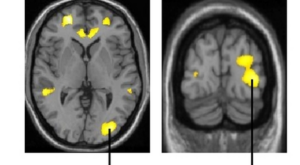 Transient structural changes caused by juggling exercises. The changes are marked yellow and are superimposed on a normalized T1-image. (From Driemeyer et al)
your left hand and right hand movement and to link perceptual events, seeing the balls, with motor the actions of throwing and catching the balls.
It has been shown in several studies (Driemeyer et al,Boyke et al) that during the acquisition of this new motor skill certain areas of the brain, such as the hippocampus show a significant increase in gray matter.
From the beginning of the seminar we want to work on modifying our own brain structure, you should thus all come up with a new skill to learn, it could be juggling, table football or any other new skill you always wanted to learn. As part of the seminar you should find a way of documenting your learning process.
drawings of the cells of the retina by anatomist Santiago Ramón y Cajal
In 1906 was awarded the nobel prize for physiology and medicine together with . Both were rewarded for their substantial findings and histological analysis of nervous cell tissues. Golgi had invented the a silver staining technique that renders visible about 10% of the cells.
Santiago Ramón y Cajal had refined the golgi staining method and concluded from his observations that nerves are cells, seperate entities that have endings and physically separated. In contrast Camillo Golgi was in favor of the reticular theory, claiming that the nerves were not separate but rather a huge fully connected rhizomatic structure.
Transient structural changes caused by juggling exercises. The changes are marked yellow and are superimposed on a normalized T1-image. (From Driemeyer et al)
your left hand and right hand movement and to link perceptual events, seeing the balls, with motor the actions of throwing and catching the balls.
It has been shown in several studies (Driemeyer et al,Boyke et al) that during the acquisition of this new motor skill certain areas of the brain, such as the hippocampus show a significant increase in gray matter.
From the beginning of the seminar we want to work on modifying our own brain structure, you should thus all come up with a new skill to learn, it could be juggling, table football or any other new skill you always wanted to learn. As part of the seminar you should find a way of documenting your learning process.
drawings of the cells of the retina by anatomist Santiago Ramón y Cajal
In 1906 was awarded the nobel prize for physiology and medicine together with . Both were rewarded for their substantial findings and histological analysis of nervous cell tissues. Golgi had invented the a silver staining technique that renders visible about 10% of the cells.
Santiago Ramón y Cajal had refined the golgi staining method and concluded from his observations that nerves are cells, seperate entities that have endings and physically separated. In contrast Camillo Golgi was in favor of the reticular theory, claiming that the nerves were not separate but rather a huge fully connected rhizomatic structure.
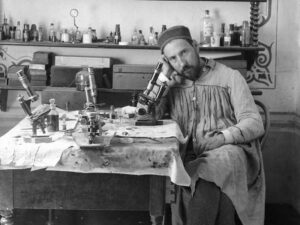
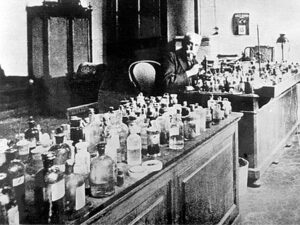 We substitute instead a vocabulary suited to a fluid organic system with certain thermodynamic properties. Another example is the localist versus distributed representation debate. The localist position is best illustrated with the grandmother cell concept, which is the idea that whenever you see your grandmother one specific nervous cell becomes active. This idea has recently gained some experimental support from single cell recordings in human subjects, and is also referred to as the Jennifer Aniston cell. In contrast to this localist view, (information is stored in cell that can be localized) is the idea of distributed representation, that claims that viewing your grandmother or Jennifer Aniston activates a distributed activation pattern of assemblies of neural structure.
Another important breakthrough in understanding the function of nervous networks was the experiment from Otto Loewi in 1921 that proved that nervous cells
We substitute instead a vocabulary suited to a fluid organic system with certain thermodynamic properties. Another example is the localist versus distributed representation debate. The localist position is best illustrated with the grandmother cell concept, which is the idea that whenever you see your grandmother one specific nervous cell becomes active. This idea has recently gained some experimental support from single cell recordings in human subjects, and is also referred to as the Jennifer Aniston cell. In contrast to this localist view, (information is stored in cell that can be localized) is the idea of distributed representation, that claims that viewing your grandmother or Jennifer Aniston activates a distributed activation pattern of assemblies of neural structure.
Another important breakthrough in understanding the function of nervous networks was the experiment from Otto Loewi in 1921 that proved that nervous cells
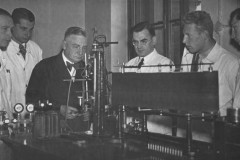
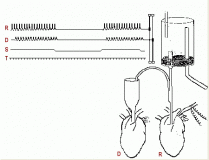 but the next day he could not read his notes. The next night he had the same dream again, this time he directly stood up and went to his lab to perform the experiment (from Wikipedia). This anecdote is not only curious but also links to an important factor on learning which is sleep. There is a recent study by Wagner et. al. that showed significant effect on how sleep is related to sudden insights. It has been also shown that sleep is important for consolidating memory see (Diekelmann & Born) for a review. The Effect of memory consolidation during sleep can be modulated by boosting slow oscillations during sleep (Marshall et. al.).
In 1949 Donald O. Hebb published his ground breaking book The Organisation of Behavior which marked a departure from the dominant behaviorism linking the nervous system to behavior. The main postulate of the book (quote from Wikipedia) Let us assume that the persistence or repetition of a reverberatory activity (or “trace”) tends to induce lasting cellular changes that add to its stability.… When an axon of cell A is near enough to excite a cell B and repeatedly or persistently takes part in firing it, some growth process or metabolic change takes place in one or both cells such that A’s efficiency, as one of the cells firing B, is increased can be paraphrased with fire together — wire together.
Wilder Penfield was a neurosurgeon who worked at the same university as Donald
but the next day he could not read his notes. The next night he had the same dream again, this time he directly stood up and went to his lab to perform the experiment (from Wikipedia). This anecdote is not only curious but also links to an important factor on learning which is sleep. There is a recent study by Wagner et. al. that showed significant effect on how sleep is related to sudden insights. It has been also shown that sleep is important for consolidating memory see (Diekelmann & Born) for a review. The Effect of memory consolidation during sleep can be modulated by boosting slow oscillations during sleep (Marshall et. al.).
In 1949 Donald O. Hebb published his ground breaking book The Organisation of Behavior which marked a departure from the dominant behaviorism linking the nervous system to behavior. The main postulate of the book (quote from Wikipedia) Let us assume that the persistence or repetition of a reverberatory activity (or “trace”) tends to induce lasting cellular changes that add to its stability.… When an axon of cell A is near enough to excite a cell B and repeatedly or persistently takes part in firing it, some growth process or metabolic change takes place in one or both cells such that A’s efficiency, as one of the cells firing B, is increased can be paraphrased with fire together — wire together.
Wilder Penfield was a neurosurgeon who worked at the same university as Donald
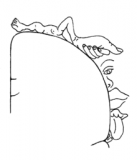
 O. Hebb at Mc. Gill University in Montreal. He had developed a surgery to treat patient with severe epilepsy, by locally destroying nerve tissue. The operations were conducted by opening the skull and only under local anesthesia, the patients were awake during the operation. By locally stimulating the nerve tissue he could map regions of neural tissue to motor function. Based on these mappings the cortical homunculus was constructed.
O. Hebb at Mc. Gill University in Montreal. He had developed a surgery to treat patient with severe epilepsy, by locally destroying nerve tissue. The operations were conducted by opening the skull and only under local anesthesia, the patients were awake during the operation. By locally stimulating the nerve tissue he could map regions of neural tissue to motor function. Based on these mappings the cortical homunculus was constructed.
 David Hockney, still from “The Jugglers, June 24th 2012,” 2012. © David Hockney. Image courtesy Hockney Pictures and Pace Gallery.
David Hockney, still from “The Jugglers, June 24th 2012,” 2012. © David Hockney. Image courtesy Hockney Pictures and Pace Gallery.
 Transient structural changes caused by juggling exercises. The changes are marked yellow and are superimposed on a normalized T1-image. (From Driemeyer et al)
your left hand and right hand movement and to link perceptual events, seeing the balls, with motor the actions of throwing and catching the balls.
It has been shown in several studies (Driemeyer et al,Boyke et al) that during the acquisition of this new motor skill certain areas of the brain, such as the hippocampus show a significant increase in gray matter.
From the beginning of the seminar we want to work on modifying our own brain structure, you should thus all come up with a new skill to learn, it could be juggling, table football or any other new skill you always wanted to learn. As part of the seminar you should find a way of documenting your learning process.
drawings of the cells of the retina by anatomist Santiago Ramón y Cajal
In 1906 was awarded the nobel prize for physiology and medicine together with . Both were rewarded for their substantial findings and histological analysis of nervous cell tissues. Golgi had invented the a silver staining technique that renders visible about 10% of the cells.
Santiago Ramón y Cajal had refined the golgi staining method and concluded from his observations that nerves are cells, seperate entities that have endings and physically separated. In contrast Camillo Golgi was in favor of the reticular theory, claiming that the nerves were not separate but rather a huge fully connected rhizomatic structure.
Transient structural changes caused by juggling exercises. The changes are marked yellow and are superimposed on a normalized T1-image. (From Driemeyer et al)
your left hand and right hand movement and to link perceptual events, seeing the balls, with motor the actions of throwing and catching the balls.
It has been shown in several studies (Driemeyer et al,Boyke et al) that during the acquisition of this new motor skill certain areas of the brain, such as the hippocampus show a significant increase in gray matter.
From the beginning of the seminar we want to work on modifying our own brain structure, you should thus all come up with a new skill to learn, it could be juggling, table football or any other new skill you always wanted to learn. As part of the seminar you should find a way of documenting your learning process.
drawings of the cells of the retina by anatomist Santiago Ramón y Cajal
In 1906 was awarded the nobel prize for physiology and medicine together with . Both were rewarded for their substantial findings and histological analysis of nervous cell tissues. Golgi had invented the a silver staining technique that renders visible about 10% of the cells.
Santiago Ramón y Cajal had refined the golgi staining method and concluded from his observations that nerves are cells, seperate entities that have endings and physically separated. In contrast Camillo Golgi was in favor of the reticular theory, claiming that the nerves were not separate but rather a huge fully connected rhizomatic structure.

 We substitute instead a vocabulary suited to a fluid organic system with certain thermodynamic properties. Another example is the localist versus distributed representation debate. The localist position is best illustrated with the grandmother cell concept, which is the idea that whenever you see your grandmother one specific nervous cell becomes active. This idea has recently gained some experimental support from single cell recordings in human subjects, and is also referred to as the Jennifer Aniston cell. In contrast to this localist view, (information is stored in cell that can be localized) is the idea of distributed representation, that claims that viewing your grandmother or Jennifer Aniston activates a distributed activation pattern of assemblies of neural structure.
Another important breakthrough in understanding the function of nervous networks was the experiment from Otto Loewi in 1921 that proved that nervous cells
We substitute instead a vocabulary suited to a fluid organic system with certain thermodynamic properties. Another example is the localist versus distributed representation debate. The localist position is best illustrated with the grandmother cell concept, which is the idea that whenever you see your grandmother one specific nervous cell becomes active. This idea has recently gained some experimental support from single cell recordings in human subjects, and is also referred to as the Jennifer Aniston cell. In contrast to this localist view, (information is stored in cell that can be localized) is the idea of distributed representation, that claims that viewing your grandmother or Jennifer Aniston activates a distributed activation pattern of assemblies of neural structure.
Another important breakthrough in understanding the function of nervous networks was the experiment from Otto Loewi in 1921 that proved that nervous cells

 but the next day he could not read his notes. The next night he had the same dream again, this time he directly stood up and went to his lab to perform the experiment (from Wikipedia). This anecdote is not only curious but also links to an important factor on learning which is sleep. There is a recent study by Wagner et. al. that showed significant effect on how sleep is related to sudden insights. It has been also shown that sleep is important for consolidating memory see (Diekelmann & Born) for a review. The Effect of memory consolidation during sleep can be modulated by boosting slow oscillations during sleep (Marshall et. al.).
In 1949 Donald O. Hebb published his ground breaking book The Organisation of Behavior which marked a departure from the dominant behaviorism linking the nervous system to behavior. The main postulate of the book (quote from Wikipedia) Let us assume that the persistence or repetition of a reverberatory activity (or “trace”) tends to induce lasting cellular changes that add to its stability.… When an axon of cell A is near enough to excite a cell B and repeatedly or persistently takes part in firing it, some growth process or metabolic change takes place in one or both cells such that A’s efficiency, as one of the cells firing B, is increased can be paraphrased with fire together — wire together.
Wilder Penfield was a neurosurgeon who worked at the same university as Donald
but the next day he could not read his notes. The next night he had the same dream again, this time he directly stood up and went to his lab to perform the experiment (from Wikipedia). This anecdote is not only curious but also links to an important factor on learning which is sleep. There is a recent study by Wagner et. al. that showed significant effect on how sleep is related to sudden insights. It has been also shown that sleep is important for consolidating memory see (Diekelmann & Born) for a review. The Effect of memory consolidation during sleep can be modulated by boosting slow oscillations during sleep (Marshall et. al.).
In 1949 Donald O. Hebb published his ground breaking book The Organisation of Behavior which marked a departure from the dominant behaviorism linking the nervous system to behavior. The main postulate of the book (quote from Wikipedia) Let us assume that the persistence or repetition of a reverberatory activity (or “trace”) tends to induce lasting cellular changes that add to its stability.… When an axon of cell A is near enough to excite a cell B and repeatedly or persistently takes part in firing it, some growth process or metabolic change takes place in one or both cells such that A’s efficiency, as one of the cells firing B, is increased can be paraphrased with fire together — wire together.
Wilder Penfield was a neurosurgeon who worked at the same university as Donald

 O. Hebb at Mc. Gill University in Montreal. He had developed a surgery to treat patient with severe epilepsy, by locally destroying nerve tissue. The operations were conducted by opening the skull and only under local anesthesia, the patients were awake during the operation. By locally stimulating the nerve tissue he could map regions of neural tissue to motor function. Based on these mappings the cortical homunculus was constructed.
O. Hebb at Mc. Gill University in Montreal. He had developed a surgery to treat patient with severe epilepsy, by locally destroying nerve tissue. The operations were conducted by opening the skull and only under local anesthesia, the patients were awake during the operation. By locally stimulating the nerve tissue he could map regions of neural tissue to motor function. Based on these mappings the cortical homunculus was constructed.